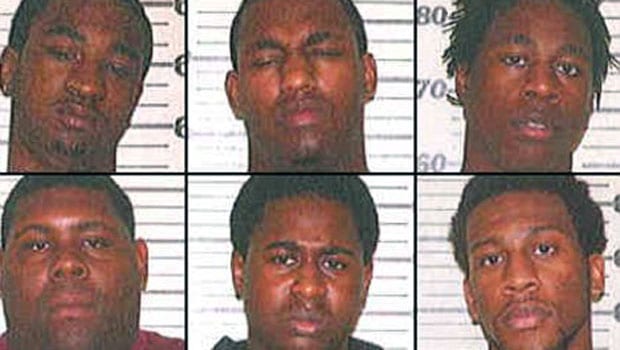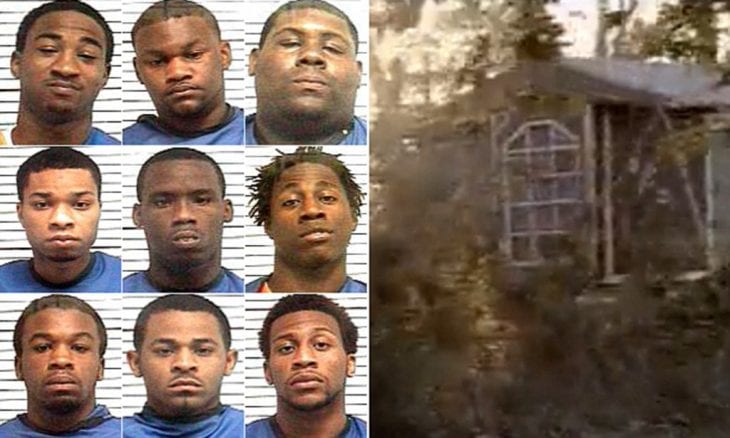UPDATE: A spokeswoman for The New York Times defended the article to Yahoo.com’s Cutline blog yesterday and the paper also published a critical letter to the editor online.
A tragic gang rape story out of Cleveland, Texas, has been made all the more worse by a New York Times article that tells us the 11-year-old victim hung out with teenaged boys, wore makeup, and “dressed older.” So many journalistic aspects of this New York Times article, written by James C. McKinnley, Jr., are so badly handled with regards to sensitivity towards sexual assault victims that it makes me want to haul their entire editorial team in for an educational session on rape myths. The basic facts of the story are that on November 28, 2010, an 11-year-old girl was gang raped by 18 men, ranging from middle schoolers to high schoolers to a 27-year-old, in a house and a trailer in Cleveland, Texas. According to the Times, the girl rode in a car with a 19-year-old guy that she knew to a house, then to an impoverished trailer park called “the Quarters,” and a group of guys threatened to beat her if she didn’t submit to getting raped. By 18 of them. Some of them videorecorded the gang rape on their cell phones and authorities learned what had happened when an elementary school student who had seen someone’s video told a teacher about it. The victim has been transferred to another school district; the school-aged boys have not returned to school.
Clearly, there are no words to convey how horrible this crime is.
But The New York Times, in its reportage, said plenty. While I’ll concede that the editorial process at any newspaper/magazine/blog is generally unclear to readers and it’s difficult to know how to apportion blame to the author or the editor, or how much, I venture to guess that a whole lot of “FAIL” in this article means there’s plenty of blame to go around for everyone based on how this article went to press:
The 11-year-old victim wore makeup, dressed older, and hung out with older boys. This excerpt from the Times piece on the East Texas gang rape is by far the most galling:
“Residents in the neighborhood where the abandoned trailer stands … said [the victim] dressed older than her age, wearing makeup and fashions more appropriate to a woman in her 20s. She would hang out with teenage boys at a playground, some said.”
Now, to be fair to the reporter, I understand that he was trying to describe the context: the young victim was rather sexualized for an 11-year-old and hung out with older men. They were older men with criminal records, in fact. While a gang rape would be no less horrible if it were an 11-year-old sexually assaulted by 18 other 11-year-olds in somebody’s rec room, I can understand how the reporter is trying to explain to us that this victim hung out with a “bad” crowd, and a “bad” crowd hung out with this victim.

Source: CBS News
But why the hell is it necessary to tell us the victim wore makeup and dressed like she was in her 20s? Why is it necessary to conjure up the image of this 11-year-old child as some tart who was asking for it? There is no goddamn reason I need to know how this 11-year-old victim, or any other victim of sexual assault, dressed and wore makeup before or during the time she was physically threatened and forcibly raped. And there is no goddamn excuse for furthering the stereotype in Times readers’ minds that there are “good victims” (who were snatched on the side of the road while picking daisies and didn’t deserve to be raped) and bad victims (who should not have done XYZ to prevent/not provoke the men and boys from raping them). Those paradigms don’t exist. Anything else is called slut shaming. Anything else is called victim blaming.
Breathe in. Breathe out. Let’s move on, shall we?
The victim’s trauma is unremarked upon but one quote frets that the perpetrators’ lives will be ruined. This second excerpt from the Times is a very close second for the most galling part of the gang rape article:
“It’s just destroyed our community,” said Sheila Harrison, 48, a hospital worker who says she knows several of the defendants. “These boys have to live with this the rest of their lives.”
Now, it is possible that Sheila Harrison and 100 other individuals interviewed by the Times said something like, “This poor girl! She has to live with this for the rest of her life!” But someone — maybe the reporter, maybe the various Times editors that edited the story before it was published — didn’t go with a quote like that. They went with a quote about how the boys will have to “live with this.” Astounding.
Was it just a callous omission? Or was the Times just trying to give some local flavor, so to speak, as to the prevailing opinions of the importance of the effect on the perpetrators’ lives versus the life of the victim? It’s too subtle to say for sure. But when a newspaper outlet includes a quote that suggests that 18 rapists are the ones being victimized without any sort of counter-balancing quote about the young victim who was traumatized, I’m inclined to go with “callous omission.”

Source: Daily Mail
Oh, but there’s more quotes.
Let’s blame the victims’ mother, shall we? Here’s another gem:
“Where was her mother? What was her mother thinking?” said Ms. Harrison, one of a handful of neighbors who would speak on the record. “How can you have an 11-year-old child missing down in the Quarters?”
We can all agree that 11-year-olds perhaps should not be hanging out with much older kids or 27-year-old adults, and especially not with older boys with criminal records. No one is debating that and one does not have to be a parent himself or herself to question why this victim’s parents were allowing her to socialize with much older kids. But still the fact remains that the onus is on the boys and men not to be rapists. Period. End of story.
It’s beyond unfortunate that The New York Times, a supposedly liberal, progressive newspaper run by extremely well-educated men and women, would publish an article that’s so problematic. I, for one, will be watching to see what “letters to the editor” the paper publishes and whether there will be any reaction from the paper’s ombudsman (called the “public editor”).
You can react to the NYT piece yourself by:
- Submitting a letter to the editor at letters@nytimes.com or Letters to the Editor, The New York Times, 620 Eighth Avenue, New York, NY 10018
- Replying to @publiceditor or @nytimes on Twitter
- Signing this petition on Change.org
- Emailing the Times ombudsman/public editor, Arthur Brisbane, at {encode=”public@nytimes.com” title=”public@nytimes.com”} or by writing to the above address
If Frisky readers contact The New York Times in any way about this article, please let us know about it in the comments and about any response you may receive.
Original by: Jessica Wakeman
